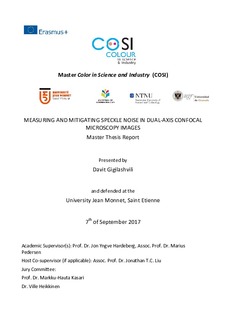| dc.description.abstract | Speckle noise is a form of multiplicative noise that corrupts the quality of medical images. It is well described and studied in medical ultrasound imaging, but less attention has been paid to its presence in reflectance microscopy images. Presence of the speckle noise not only limits the application of further post-processing and computer vision techniques, like edge detection, it also makes diagnosing more difficult and less reliable for the physicians.
Many speckle mitigation techniques have been studied by various researchers, but the vast majority of them limit itself just to single image of the target tissue. While averaging of uncorrelated images of the same tissue taken from different spatial conditions is mentioned among the possibilities of speckle mitigation, it is considered too complicated due to the need of several image acquisitions.
In my study, I decided to use the videos recorded by dual-axis confocal microscopes that contain lots of redundant data and can be considered a substitute for several independent image acquisitions. The separate frames extracted from the video sequence contain the overlapping regions of the same tissue – providing uncorrelated data from different spatial positions. The study was dedicated to explore the potential usage of this redundant data for speckle mitigation purposes. On the one hand, optimal ways for detection and registration of the overlapping regions among several frames were studied, whilst on the other hand, different ways of utilization of the redundant data was explored and I tried to go beyond simple averaging and apply more sophisticated approaches. Finally, our approach was compared against conventional methodologies under different circumstances.
The Molecular Biophotonics Laboratory at the University of Washington, led by Prof. Jonathan T.C. Liu is focused on designing dual-axis confocal microscopes. As their microscopes use reflectance based technology (in contrast to fluorescence-based microscopes that are free from speckle noise), mitigation of the speckle noise is named among the primary concerns of the team at the University of Washington.
The project carried out by Davit Gigilashvili was a collaboration between Norwegian University of Science and Technology and the University of Washington – supervised by Prof. Jon Yngve Hardeberg and Prof. Marius Pedersen on Norwegian side and by Prof. Jonathan T.C. Liu on American side. | nb_NO |
